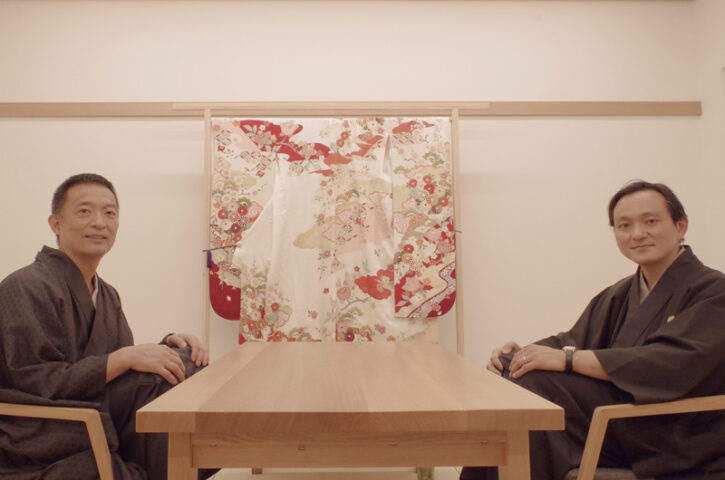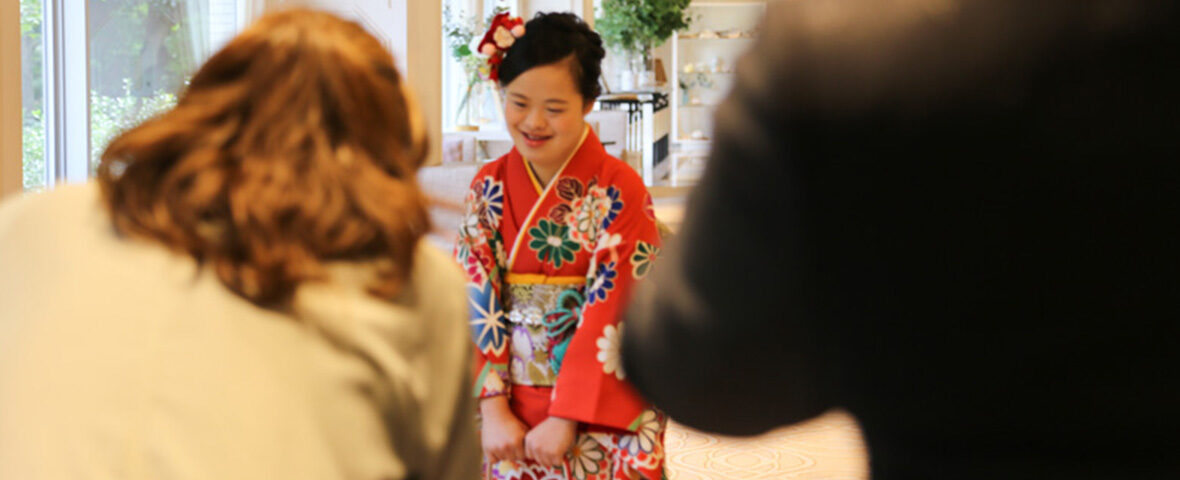[Conclusion of the S-SAP Agreement]
Special dialogue between Ken Hasebe, Mayor of Shibuya City, and Takayuki Yajima, President and Representative Director of Yamato Co., Ltd.
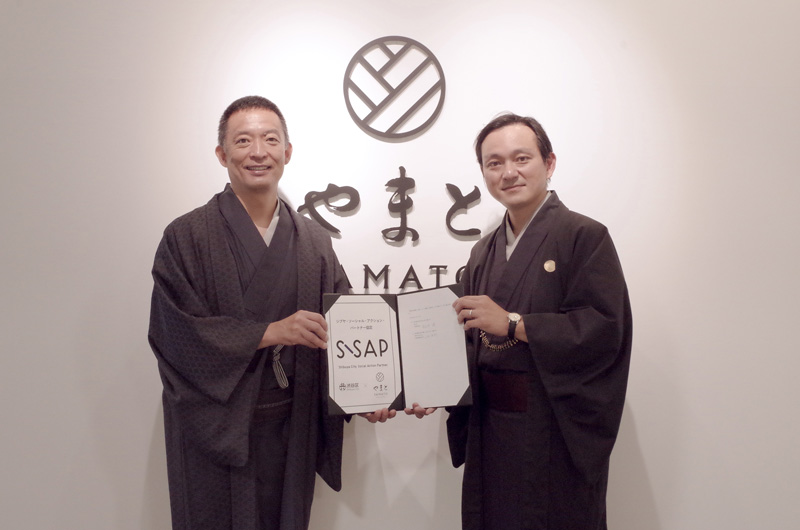

On Thursday, May 19, 2022, Yamato Co., Ltd. and Shibuya City concluded the Shibuya Social Action Partner Agreement (hereinafter called S-SAP Agreement), a public-private partnership system the city concludes with companies and universities based in the city to work with them to solve local social issues.
In commemoration of the conclusion of the S-SAP Agreement, we interviewed Ken Hasebe (hereinafter referred to as Hasebe), Mayor of Shibuya City, and Takayuki Yajima, President and Representative Director of Yamato Co., Ltd., about how motivated they were to make cooperative efforts, while they also dialogued with each other.
Beginning of the cooperative efforts between Yamato and Shibuya City
――We asked Mayor Hasebe to wear a kimono. How do you feel?
- HasebeI feel tense. I think I look better in it than I expected (laughs).
- YajimaIt looks so good on you. You should wear a kimono in your daily life.
- HasebeI would like to wear it if the occasion arises. The color you chose for me is very nice. I think the kimono is made of a fabric made in Niigata and the haori is made of a fabric made in Tango. Am I correct? These patterns seem like traditional ones but this kimono and haori make me feel comfortable because they look modern.
- YajimaThank you. The kimono is made of Tokamachi Tsumugi from Niigata and the haori is made of Tango Omeshi from Kyoto. We place importance on making everyone involved in the manufacturing process identifiable. When I see a kimono, I can see the faces of the people involved in the process of making it in my mind’s eye. I can see their faces right now.
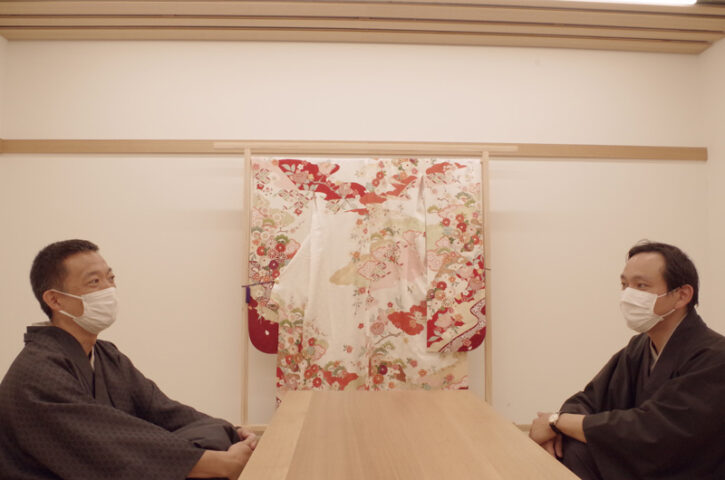
――How did you two meet?
- HasebeI think we first met for the first time 2 or 3 years ago.
- YajimaThat’s right. We’ve known each other since we met through our mutual friend from high school about 2 years ago.
- HasebeWhen I first met Mr. Yajima, he wore a kimono and a hat in the Taisho modern style and looked fantastic. I learned that we could wear a kimono like that. I got interested in the kimono right away and visited the store of THE YARD nearby.
At that time, you told me that you wanted to enable disabled people to wear a kimono. - YajimaWhen I reflect on how we conducted business, I feel sorry that we looked only at able-bodied people. A new employee who joined Yamato about 5 years ago made me realize it. She told me that she wanted to enable disabled people to wear a furisode. I think a culture should be there to support everyone. It should not be something that tells people to do this or not to do that. I think how a culture supports people and the culture itself will change with the times. I was so glad that Mr. Hasebe willingly agreed with my idea when I told him that I wanted to do something for disabled people.
- HasebeI feel so grateful for you because you took action immediately and your efforts bore fruit.
Shibuya City wanted to implement some programs to introduce the Japanese culture to people around the world including tourists if the COVID-19 pandemic had not struck. When I met Mr. Yajima, I thought we could do many things together. - YajimaWe came up with various ideas when we were just talking casually.
I find Shibuya Font, which Shibuya City is working on, very interesting. For example, we can make washcloths or yukatas for tourists from abroad using the Hachiko designs created in Shibuya Font. It may be a small thing to start with, but I want to make it a project that makes shoppers and those who designed them happy.
≪Reference/Japanese≫
・“Photoshoot in commemoration of your coming of age” held for new adults with disabilities in October 2021
・Shibuya Font
Students studying in Shibuya design fonts and patterns using the letters and pictures drawn by people with disabilities who live or work in Shibuya. Shibuya Font provides those fonts and patterns as public data. We would like many more people to love Shibuya, take pride in the city, and learn about what people with disabilities are doing by making those fonts and patterns available for use in various things and activities. Born out of those wishes, Shibuya Font is Japan’s first social action based in Shibuya.
https://www.shibuyafont.jp/
High school days that made the two take pride in the city
――You two are from the same high school. Could you talk about your high school memories? What kind of a high school student were you?
- YajimaDid you belong to any club, Mr. Hasebe?
- HasebeI belonged to the baseball club at first. Then I moved to the judo club within one year. I played sport in the club and PE was my favorite class back in high school.
- YajimaI was also occupied with my club activities. I remember that round school building.
- HasebeThat’s right, it was round.
And our school uniform had accordion pleats. It had a stand-up collar with hook-and-eye closures, not buttons. It was like a navy-blue naval academy uniform. - YajimaI really loved that uniform.
- HasebeYes, I liked it too. I always thought it was a great uniform.
Though I was born and raised in Harajuku, I biked to and from the school in Suginami City. It was such a hassle to go to school by train because I had to change trains and it took almost an hour. However, it took me a little less than 30 minutes by bicycle to get there. I passed through this area, Sendagaya, and the Honcho area to get to the school. The Tokyo Metropolitan Government Office was completed while I biked to and from school for 3 years.
- YajimaWas it under construction?
- HasebeYes, it was. It was completed right before my graduation. It was right on my route to school.
After entering high school, many people asked me which junior high school I was from. I said, “I’m from Harajuku Junior High School,” and then they went “Wow!” in surprise. - YajimaHarajuku, Shibuya, and Shinjuku were the places where people went to play and everyone had a longing for those areas.
- HasebeThough I didn’t realize it back in junior high school, I went to a school outside Shibuya City for the first time as a high school student and I felt glad and proud because everyone said, “I’m jealous that you are from Shibuya.” Maybe it made me take more pride in my city.
- YajimaIt makes sense because you grew up there.
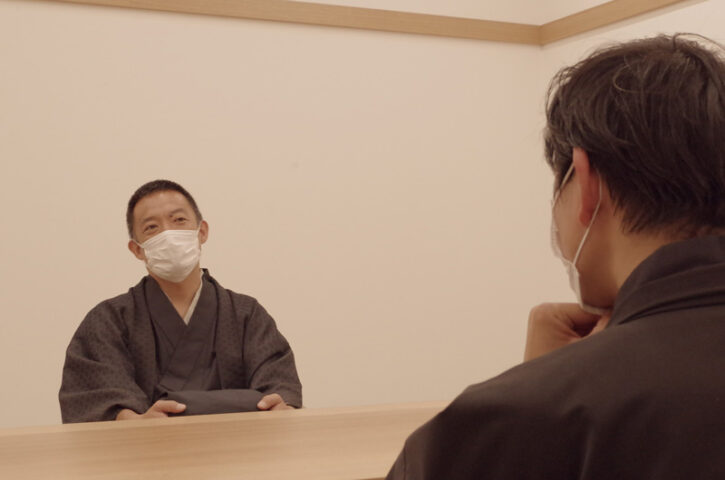
The key phrase is “turning differences into strength.”
――You have become the Mayor of your hometown Shibuya City, for which you have a special place in your heart. What kind of efforts are you making to realize the vision “Shibuya―turning differences into strength”?
- HasebeEight years have passed since I became the Mayor of Shibuya. I spent my first year working hard to come up with this phrase. I established a council to seek opinions from various people. It is a vision for the future set as the basic concept that is a top priority in Shibuya City’s policies. I created it first.
To be honest, there were some city council members who didn’t know what diversity was at that time, and many city officials didn’t understand it either. However, after the basic concept was established, they came to understand the phrase and got motivated, which I think it is a good thing in the government office. And I actually felt that things had started to change. Today, I make sure that every city official takes into consideration the basic concept when they work on any policy.
For example, if I may talk about small things, there is the sports watch.
Some sports watches measure your swimming distance and they are very convenient for visually-impaired people. They tell how much you have swum in terms of distance. However, many swimming pools ban the use of those watches.
After the basic concept had been established, some employees of city’s sports facilities proposed that we should allow the use of sports watches if they are covered. So we have changed the rules.
In addition, when it comes to the issuance of partnership certificates for LGBTQ people, our officials have actively discussed how they should handle it in their departments.
I see our officials think on their own without me telling them what to do, which reassures me. I feel that the creation of the basic concept phrase made everyone motivated and take action. I believe in the power of words. - YajimaYou established the basic concept “turning differences into strength.” That means you had the word “diversity” in your mind, right?
- HasebeThat’s right.
- YajimaThough diversity has become a familiar word today, what made you pay attention to it back then?
- HasebeI think the word diversity already existed and people used back then. I don’t think I was an early adopter. However, I’m sure that the word sounded a bit more frivolous than now.
I visited overseas cities on various occasions and saw there were various values and diverse people. I felt the same energy in Shibuya City. Growing up in such an environment may be the reason why I pay attention to diversity without thinking.
- YajimaIt is a city of diversity.
- HasebeYou are right. Though I said the city marked its 90th anniversary, when we look at the history of the city, it had been called Toyotama-gun, Tokyo before it became Shibuya City. The population was small when Sendagaya-machi, Yoyohata-machi, and Shibuya-machi merged and became Shibuya City. Edo was the area between Akasaka and the sea, so the Shibuya area was a rural area of Musashino surrounded by fields back then. In the Taisho era, people started to gather in this rural area and Meiji Jingu was built. Meiji Jingu marks its 102th anniversary this year, by the way.
Shibuya is a city that is going to be developed from now. Various people from all over Japan gather and blend in with each other in this city. Living in Shibuya, I feel that myself. Though I said Shibuya is my hometown, my grandfather and grandmother moved here from Nagano before the war. So, I’m a third generation immigrant of Shibuya. - YajimaI didn’t know your family was originally from Nagano.
- HasebeShibuya, unlike Kamakura and Kyoto, doesn’t have hundreds of years of history because it is a city made up of people from regional cities. On the other hand, I think it is the reason why people blend in with each other in this city. When young people move in to Shibuya from other parts of Japan, people living in the city accept them. Maybe it is because they think they are also from regional cities.
- YajimaThey accept new people. Or I can say they embrace them.
- HasebeI think the good thing about cities is that they have a foundation for accepting people. When we look at overseas cities, international cities such as London, Paris, and New York are like that.
- YajimaYou’re right.
- HasebeWhen I became the Mayor, I said, “London, Paris, New York, and Shibuya-ku.” I made it rhyme, with New York and Shibuya-ku, but no one got it (laughs).
- YajimaI saw it somewhere (laughs). I thought, “New York and Shibuya-ku? Wow, the rhyme is impressive.”
- HasebePeople didn’t notice such a small thing (laughs).
However, I’m glad that I was able to give citizens and city officials a global perspective by creating the slogan “London, Paris, New York, and Shibuya-ku.” - YajimaI think what you do is similar to corporate branding in many aspects, such as the power of words. When I first met you, I felt that what you told me at that time was totally different from what I thought of public administration. I learn so much from your efforts such as city branding and the creation of words that change everyone’s awareness, and catch phrases.
- HasebeThank you.
- YajimaI believe it is important to take action instead of being all talk. I think our cooperative efforts with Shibuya City such as the photoshoot for new adults with disabilities are not only actions targeted at the public but also actions targeted at our employees. If I tell our employees that we should create a society where people respect each other’s individuality, I think they will agree. However, they may wonder, “What the company will do then?” If I propose one concrete action, I think I can make them believe that they are actually doing it. The fact that we were able to hold the photoshoot last year means a lot to Yamato. No one believes me if I am all talk and no action. I must take action based on my words.
- HasebeI am grateful to you for taking concrete actions in Shibuya City. If you can let people know Yamato is such a great company, you may get more fans.
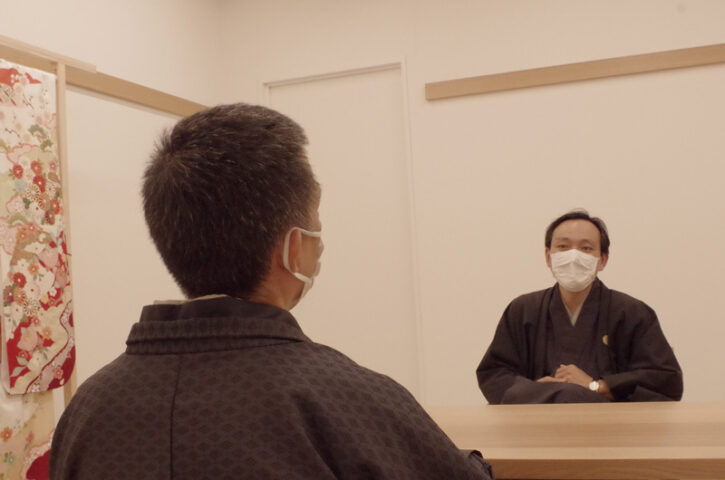
Expectations for the S-SAP Agreement
――What does Yamato expect from the S-SAP Agreement?
- YajimaWe would like to continue our efforts to support disabled people. And children. We should take care of them. I think childhood memories are important. Japanese culture seems to give the impression of being formal, rigorous, and difficult. However, I think cultures are there for people to support one another, and that’s the reason why they exist. So, I’d like to teach children that cultural activities are fun and interesting. I hope we can do something with Shibuya City in the future.
- HasebeLet’s do it. I said earlier that Shibuya City is a new city. However, it is a relatively cultural city where you can find Japanese culture. There are Japan Shogi Association and National Noh Theatre near here. Hatomori Shrine located next to Japan Shogi Association has an outdoor noh stage. The students of Hatomori Elementary School located near the shrine performed wearing Yukata rengin (group singing) on that stage the other day. They performed as an opening act for takigi-noh. As the elementary school located near the head office of Yamato is working on such a project, I wish we could do something together with that school.
We are also working with Hattori Nutrition College and they create school lunch recipes. It’s going to be interesting if we set a theme like Japanese food. There are endless possibilities.
――What does Shibuya City expect of Yamato?
- HasebeI would like many more people to wear a kimono in Shibuya City. I’d like to see people walking down a street in kimonos in Shibuya. I’ve heard from young people working in Shibuya City that they want to wear a kimono.
- YajimaIt will be interesting if we establish Yukata Day or Shibuya City Yukata Day.
- HasebeIn addition, I think it will be interesting if we produce souvenirs related to sando (an approach to Meiji Jingu). The city will undergo further changes from now on.
For example, I would like to make Nishisando more attractive. The approach in front of the torii gate has been repaired. This time, we are going to repair the rest of the approach to the Koshu Kaido and make it beautiful. As the section under the highway is now used as a bicycle parking area, we would like to place a container to run a café or build a studio to make it a mecca for shogi fans who love watching shogi games in cooperation with the Japan Shogi Association in this section. The city is trying to bring Japanese culture to the sando, so it will be interesting if we can do something together.
The green way near Nishisando will be under construction this fiscal year. Though it will take us 6 years in total, we will cultivate fields there under the concept of "FARM." As the word farm also means to grow something, we have gathered various ideas such as creating a community and making it a place where people can grow something. I’m going to develop it into something comparable to the High Line in New York. - YajimaThe High Line in New York. I know what you mean.
- HasebeIt is a development project for the residents. I’d like to work on it with the mindset that the traditional things and new things are mixed, the better. Your cooperation would be appreciated.
- YajimaI’ll think about what I can do. I’m looking forward to working with you.
